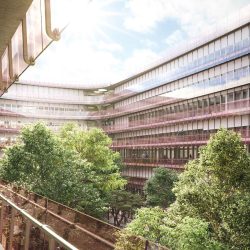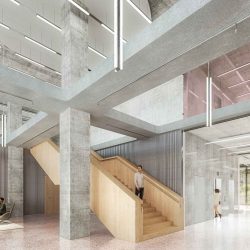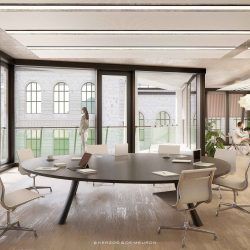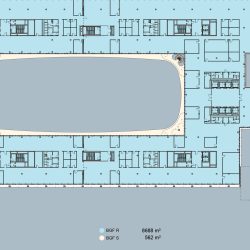
The area south of the railroad station in Munich is characterized by the compact perimeter-block construction typical of the mid-19th century: small plots of land, narrow courtyards, and heavily trafficked, generally treeless streets. Featuring a number of hotels and buildings with relatively small office units and studios, the neighborhood is lively and bustling by day thanks to a variety of ground-floor retail stores and commercial uses. When night falls, however, the lack of residents in this neighborhood becomes obvious. The popular nickname “Orientalischer Viktualienmarkt” (Oriental Food Market) implies vibrant diversity but also reveals the dense and stony nature of this district. The large-scale redevelopment and expansion of the main station in Munich will have a dramatic impact on this neighborhood, which is set to become more attractive and livable in the next few years.
A Burgeoning Railroad Neighborhood
The building housing the administration of the Postbank from the early 1990s on the block stands in contrast to the rest of the neighborhood because of its size. It occupies the entire block with the exception of a hotel on the northeastern corner. Very little light and air reaches the interior of this largely six-story perimeter-block building, with its small stacked courtyards in the central portion and almost continuous ground-floor development.
At first sight, the buildings appear to be aging and unattractive but prove, on closer inspection, to be basically solid. This factor is worth taking into account. The goal of the clients – an up-to-date, urban block that accommodates a mixture of downtown uses and meets the highest standards of quality and sustainability – can best be achieved by reusing and supplementing the existing structure. The maxim is to build on and with what is already there. In view of these considerations, it would be absurd to demolish the entire block and completely rebuild the quarter. Analysis of the buildings shows that almost two thirds of the shell could be preserved. Restriction to precise partial demolition and subsequent additions reduces dust pollution, noise, and construction traffic, saves time and makes an important contribution to sustainability. Aboveground, the dense, poorly lit interior of the block will be dismantled, gaps in the perimeter filled, and the block straightened, producing a large, continuous ring of buildings with flexible office space.
Ground-floor use will be focused on retail and restaurants, in some cases facing two sides: the street and the inner courtyard. The first belowground level on Mittererstrasse will accommodate parking for some 1000 bicycles, as well as a delivery entrance and waste disposal. Two floors, built on top of the entire block and setback like penthouses, along with uninterrupted eaves all around the complex will have a calming, streamlined effect on the urban context.
A Courtyard for Light and Air in the Neighborhood
The plot of land, comprising almost the entire block, offers a unique opportunity to create a large courtyard garden accessible to the entire neighborhood. The garden will become a magnet for the area around the main station, an oasis protected from the incessant rush of traffic, an urban forest, a green lung for the neighborhood. Evaporative cooling and natural air purification through large leaves and photosynthetic processes will generate a microclimate. A broad oval of colored glass balustrades forms an encompassing circle around the entire rectangular courtyard. The curved inner corners will make room for quiet spots or staircases to stories above. The glass balustrades will be a kind of container for the courtyard, an impression accentuated by variations in their vertical inclines: the lower third lean toward the forest, which is thus mirrored in the glass, and on the upper floors, the balustrades tilt away from the center, opening up the courtyard and reflecting the daylight into the space below.
Incorporating What is Old into What is New
The structural substance of both the old buildings and the new additions will be exposed and perceptible, revealing the powerful presence and rhythmical clarity of the existing and partially extended concrete body. Together, the old and new load-bearing structures will form a harmonious ensemble, which is differentiated, enriched, and refined through precisely tailored variations in geometry, materials, and surface treatment.
By exposing the clearly organized, “naked” loadbearing structure and accentuating the ground-floor and the corners of the buildings, the block as a whole acquires an almost classicist appearance reminiscent of the grand and sumptuous urban palaces in downtown Munich, their facades embellished with spacious arcades. Although the new complex will be modern, contemporary, and extensively glazed, it will blend into the cityscape characteristic of Munich, while simultaneously retaining some of the earthy charm of the nearby “Orientalischer Viktualienmarkt”.
Herzog & de Meuron, 2019
_




















